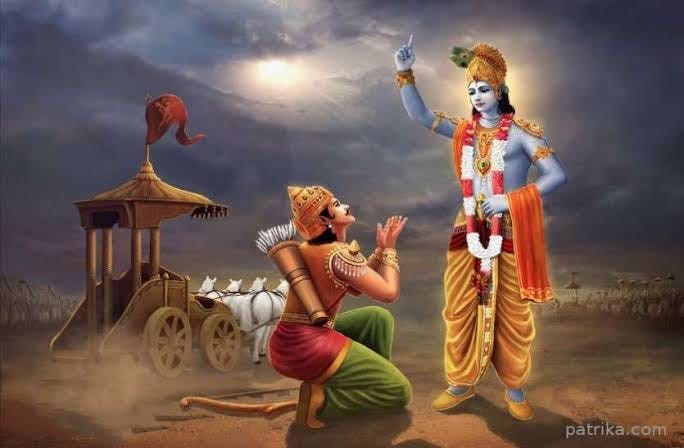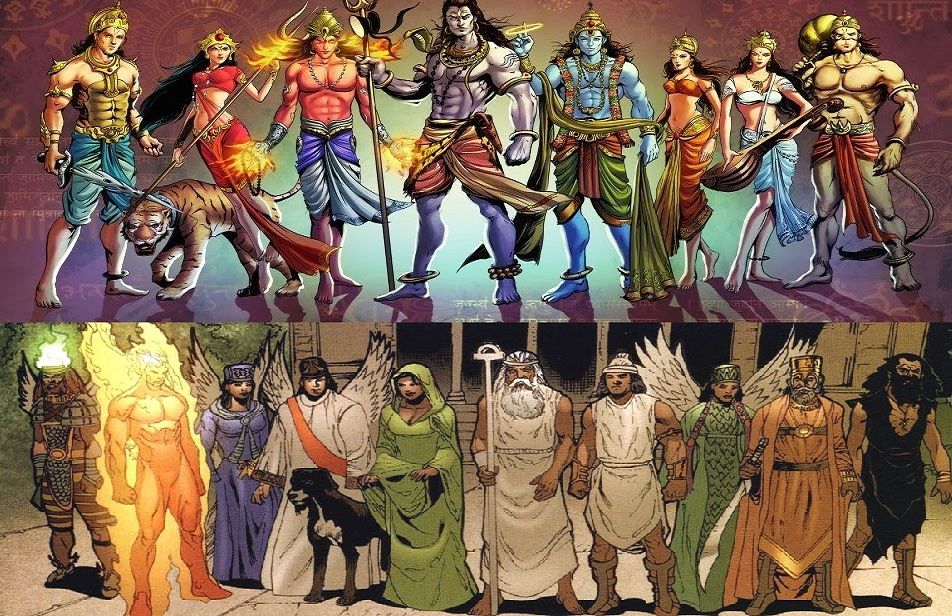
"When meditation is mastered, the mind is unwavering like the flame of a lamp in a windless place." – Bhagavad Gita 6.19

Those who lived towards the West or journeyed outwards from India were called the Asuras, while the inhabitants of India were called the Devas. In this manner, the two were built upon the same foundations but were subtly different in some aspects. In Santana Dharma and Sanatana Dharma, there are several legendary tales of battles between the two where Indra (the king of the Devas) fought against the Mahabali (the king of the Asuras) and several other powerful Asuras who were often depicted as villains. Just as Sindhu was mispronounced as Hindu, Asura was soon mispronounced as Ahura, the Gods of Zoroastrianism that developed around Arabia and probably predated the Abrahamic religions. On the other hand, the Daevas (remarkably similar to Devas) were shown as the villains whom the Ahuras often battled against to reinstate righteousness within society. While those in India remained Sun-worshippers, the Zoroastrians worshipped the Moon, and so did the upcoming religions in Arabia, such as Islam, Judaism and Christianity. However, the Moon is also a very respected celestial body in Sanatana Dharma that is worn by the great Lord Shiva as a symbol of his stringent devotion through his various phases and where the divine nectar and ambrosia of the Gods reside.
Furthermore, this explains the prominent proximity between Vedic Sanskrit and the Avestan language spoken by the Zoroastrians, but written right to left, while Sanskrit is written right to left. We can find this correlation in the similarity between the Sanatani and Zoroastrian texts as well. For example, a text in Avestan reads 'T∂m amavant∂m yazat∂m, sur∂m damohu scvist∂m' which is not only identical in terms of syntax to Sanskrit but also nearly identical to the Sanskrit verse from the Vedas that recites ‘Tam amavantam yajatam, suram dhamasu savistham’. The similarity in language between the scriptures is evident in the table below.

Zoroastrian saints are even mentioned in the Vedas such as Zarathustra or Zoroaster in the Rig Veda. In the Vedic texts, the sound Z is not widely found or used so a Z would be turned into a J. The name Zarathustra can be shortened to Zarath and then converted to Jarath. After these slight alterations in the letters, the Vedic people would have pronounced Jarath as Jarutha according to their dialect. In the Rig Veda 7.1.7, “Burn up all malice with those flames, O Agni, wherewith of old thou burntest up Jarutha, And drive away in silence pain and sickness,” the death of Jarutha is mentioned which indicates not only the common personalities between the Avestan and Rig Veda scriptures but may also be an indicator of the text’s antiquity and Zoroastrianism altogether. In Zoroastrian stories, it is believed that Zarathustra died from the fire of a star within himself or some form of lightning which matches the corresponding Vedic texts. Furthermore, the first disciple of Zarathustra, Vishtapa, is also mentioned as Istasva in the Rig Veda; the youngest son of Vishtapa, Pashtohan or also known as Chitro-mino is mentioned as Citraratha in the Rig Veda 4.30.17; Baetas (son-in-law of Zarathustra) is identified as Vetasu of the Rig Veda; and Arjaspa is thought to be Rjrasva. The following is supported by identical accounts of the character’s lives in both texts. If one reads the translation of the Sanskrit verses, one may find that Prophet Zoroaster is painted as a demon and in other Puranas like the Bhavishya Mahapurana where Prophet Muhammad is mentioned, he is portrayed as a malevolent ogre who wants to spread a religion of unrighteousness in obedience to God’s commands. However, over the ages, these scriptures have been continually falsified by missionaries to break social cohesion between different religious communities as has the Sanskrit of the Rig Veda where the language has been characterised by more development to suit the rapidly progressing environment of India which is why the Avesta may seem more archaic and occasionally mistakenly interpreted to be antecedent to Vedic Sanskrit.
On the contrary, there were also times of great friendship and demonstrations of compassion between the two. This is not only proven historically but also documented in our scriptures. For example, the wide Parsi community that thrives fluidly with the other diverse religions of India found its way from the exodus of their Arabian descendants from religious persecution by expansionist Muslim tyrants in their subcontinent and found accommodation across India. Furthermore, in the account of the fifth avatar of Vishnu, Vamana, the dwarf Avatar, granted Mahabali the boon of immortality for his great humility and devotion towards him. In the story, to regain the territory of his dear friend Indra from the Asura King Mahabali, Vishnu took the form of a Brahmin dwarf. Mahabali kindly asked the pious man what he wanted, and Vamana replied that he could take as much land as he could cover in three steps, which Mahabali obliged. Vamana increased in size to cover all three worlds and existence in two steps. Vamana asked Mahabali where to place his third step and asked him to rest his foot on his head. This great act of surrenderance to the Lord and respect was acknowledged by Vishnu and thus rewarded. Many other Asuras are also respected in Sanatani culture and scriptures, such as Vibishan, who aided Lord Rama (an avatar of Vishnu, the preserver in the Sanatani Trinity) to reinstate dharma and peace within society and Prahlada, who is the perfect exemplar of forging a loving and blissful relationship with God. In early Vedic literature, the Vedic Gods were also referred to as Asura, which shows that this term was not used to denote the demoniac but a positive term for a group of people that eventually turned negative due to their evolution.
Moreover, historical documents in the Mesopotamian region and around the Saraswati River Civilisation show friendly ancient trading links between the two civilisations and immense respect for each other. The beliefs of the two flow extremely well together such that even the Council of Dharmic Religions regards Zoroastrianism as a Dharmic religion. Considering that Zoroastrianism largely influenced the upcoming religions in Arabia that have principles akin to Sanatana Dharma, it is easy to understand how much they share in common. The friction between the two different societies is inevitable as they are two separate schools of faith with people who do not have an integral understanding of the religion or our superlative way of life who resort to violence and hatred, just as there have been historical tensions between Buddhism and Hinduism although they are both Dharmic Religions that are founded on the same principles. There is no conflict, no incompatibility at all. This quality of effortless integration due to our liberalistic ideals is precisely what renders our culture as eternal and all-encompassing.
After Abraham founded Judaism, the Abrahamic religions developed. The concepts that Abraham laid down were largely influenced by the major religion of the time, Zoroastrianism, which we know was close to Sanatana Dharma. Several components that his descendants appended contained these ideas to a large extent, such as those of Moses, David, and Jesus.